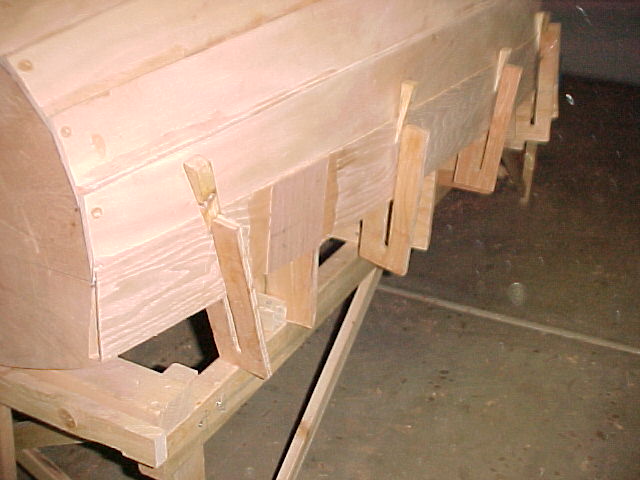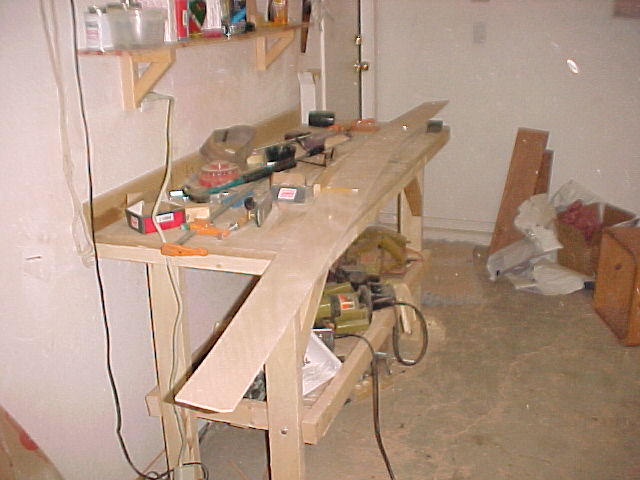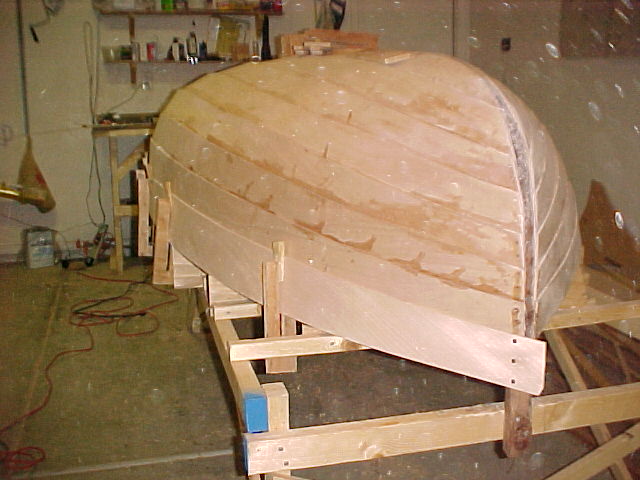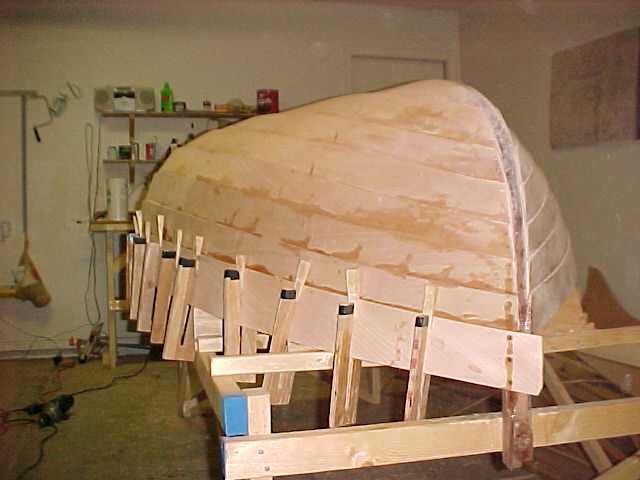
Today was the day I have been working toward for many, many months. Well, it's the first of many, many days toward which I have been working, but if I think about it that way, I'll throw away my tools and take up accounting, so I have to maintain my focus on the here and now, because I really can't stand accounting.
Anyway, I began work on the sheer strake today, which is the last plank to go on and is at least esthetically the most important one since it is the one that describes the line to which the eye is drawn. Thus, if you screw up the fairing, the boat, however well constructed at each subsequently lower plank, will look bent and lumpy and goofy. I've just about resigned myself to a bent, lumpy, goofy boat, so if I screw this up I don't think I'll be too disappointed. And I only have one shot at this, since this will use the balance of my Okoume ply (unless I order more. Not.)
Since it is such a milestone in the planking process, I thought I'd document its construction a bit more thoroughly than has been my habit so far. Here I've made the pattern from some door skin plywood. You can see that I've had to add some length to the pattern stock since the curve is some few inches longer than eight feet, the standard length for plywood.
The process is as follows. I glue up an extension on the sheet of door skin ply, then goof off while I wait for it to dry. I then just slop off a strip of door skin that I judge to be wide enough to encompass the width of the plank. I've gotten better at this, but I've made lots of mistakes on the shy side.
Anyway, I then take the rough pattern and pin it in place on the frame and tick-mark the land marks where the pattern is touching. I then trace a pencil along the lower edge of the previous plank, transferring the line to the pattern. I take the pattern to the bench where I add 5/8" to the traced line to account for the overlap, and I spring a batten along the land tick marks and trace that with a pencil. Then I whip out my trusty jig saw and commence some serious destruction.
I usually rough the pattern in, erring on the large side. I don't monkey with planing and fairing the pattern since I'm not all that confident in my jig-saw skills, which would require me to do quite a lot of fairing on the Okoume plank cut from the pattern anyway. |

Okay, I've cut the plank from the expensive wood and now I have it on the bench where I'm spending the time I should have spent on all the other planks getting a fair line. A block plane and a hand sanding block do the job here, and I have to say, I'm pretty pleased with the job I've done. This took a lot longer than it should have since I had to sand all the gobs of old epoxy off the bench first.
|

I've pinned the plank to the frame and fastened it fore and aft with bronze screws. There's no glue yet, I've just checked the fit and fairness of the plank, and finding it acceptable, I've screwed it to the stem and transom. These screws will be used both as a way to achieve the original fit after the epoxy is slathered on, and as a way to hold the plank in place while it sets. Once the curing is done, I'll remove them, which is easy since I coat them in liquid soap (Dial Anti-Bacterial) prior to setting them. The fairing is actually not too bad, and I'm inordinately pleased with myself.
|

At this stage I've applied the epoxy, placed the plank, set the clamps and driven the screws. I first mix the epoxy and wet out both areas to be glued on all receiving surfaces. This is to saturate the wood and prevent starvation, a situation in which the epoxy is drawn into the wood after clamping, which will result in an embarrassingly wet day at some point in the future. After that I mix in some silica micro-balloons to thicken the epoxy mixture so that it will nicely fill in all the gaps my poor joinery work leaves. Epoxy is wonderful. I really glop it on thick, so I've learned to wrap my clamps with electrical tape at the ends to prevent them from being glued to the inside. I've actually done that quite a bit, and I'm kind of dreading seeing what the inside looks like.
|


 Winner
of the coveted Walsh Award!
Winner
of the coveted Walsh Award!